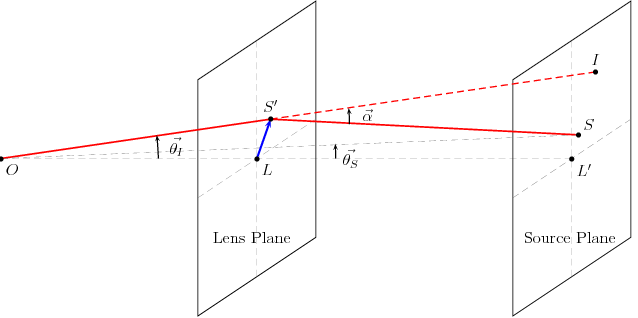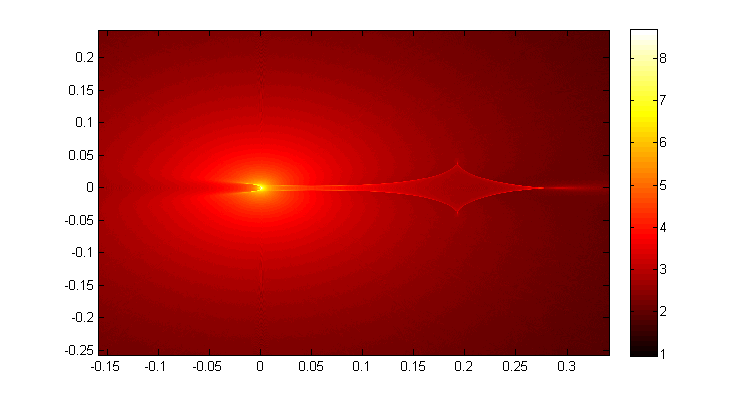REU Project Short Description and Goals
Dr. Larry Weaver was my mentor for the summer and I helped him with some computational stuff for gravitational lensing. During this time, I learned a whole lot about gravitational lensing, cosmology, mathematical physics, and research in general.
I developed some code to visualize various aspects of different gravitational lensing systems, such as single point mass, binary systems (planet-star lens system), SIS (Singular Isothermal Sphere) galaxy lens and NSIS (Non-SIS) galaxy lens. The visualizations include finding image positions, critical curves, caustics, and lightcurves. Primarily, I used MATLAB for basic calculations and visualizing; in some cases, I used Python/Matplotlib for visualizing as well. In addition, for time consuming and numerically intensive calculations such as the ray-shooting method, I used C.
While writing the tools required for visualizing and generating plots, with Dr. Weaver's informal lecturing and guidance, I was able to learn a lot of the physical and mathematical theory behind gravitational lensing.
The accurate prediction of the deflection angle due to sun for grazing light rays from distant sources was one of the first experimental verifications of Einstein's General Relativity theory. In recent times, gravitational lensing has become a very important tool in astrophysics; it is used extensively in observations of distant universe, dark matter, and exoplanets.
Project Goals
The project proposal for this REU project (by Dr. Weaver) reads as,Gravity bends light just as a lens made of glass does. This effect is now a standard tool of astrophysics. It has been used to discover planets, measure the Hubble constant, and search for dark matter in our galaxy.
I want to understand gravitational lensing better so this summer I want to calculate the properties of several lensing systems in several ways. The math involved is only elementary geometry and algebra but the computations cannot be done in closed form, a lot of computer assistance is needed. In particular, it will be necessary to find useful way of displaying the results in order to understand them. The student who takes this project will need to have a lot of pre-existing computer-savvy. I can help a lot with the math and physics, but the student must bring in experience with computers. Depending on the student’s background there may be opportunity to learn a little general relativity, too.
Introduction to GL
Click here to read a document which I wrote a few weeks after the REU started to test my own understanding of the very basics of gravitationa lensing; it does not cover much. I followed the books Gravitational Lensing by Schneider et al., and Singularity Theory and Gravitational Lensing by Petters et al., in addition to many reviews and papers on the subject by various authors.
If you are serious about learning more about gravitational lensing, you may want to check some of the following links that include review articles, lecture notes, and papers on gravitational lensing.
Lectures/Reviews/Articles
- Gravitational Lensing in Astronomy by Joachim Wambsganss
- Gravitational Lensing Wiki
- Introduction to Gravitational Lensing - Materials for a course
- Lectures on Gravitational Lensing
Some important historical papers
- The Origin of Gravitational Lensing: A Postscript to Einstein's 1936 Science Paper
- First gravitational lens discovery paper by Walsh et al.
- Galactic microlensing by the galactic halo by Paczynski
Other interesting papers/articles
Final Presentation
Click here for the pdf of my final presentation.
One of the lightcurves (corresponding to the detection of two Jupiter/Saturn type planets orbiting a star) was taken from the MicroFUN website), which I forgot to acknowledge in the presentation slides.
The presentation was created using LaTeX and beamer. The diagrams were created using PSTricks. Click here for the LaTeX/beamer source code of the presentation. You will not be able to compile it without the figures. But, if you are learning LaTeX/beamer, you can use the source code as a reference.
About Me
I came to the United States from Nepal in August 2006 to pursue my undergraduate education. I go to the University of Central Arkansas located in Conway, AR.
And, my name happens to be Saroj Adhikari.
Links to some of the tools that I use (possibly I used most of these during my REU as well)
The first two are commertial products while the rest are open source.- Mathematica
- MATLAB
- Python Programming Language - general purpose programming
- Matplotlib - MATLAB like plotting in python
- Octave - Numerical computations
- Gnuplot- plotting
- LaTeX - for typesetting
- PSTricks - for graphics on LaTeX
- The LaTeX Beamer Class - for preparing presentations
Now, some random stuff
- KSU REU was a great experience.
- We had a GRE study group during the summer and we did not even complete one set of problems meeting multiple times.
- Necessity is the mother of invention does not imply Invention is a son of necessity.
- How random is random?


